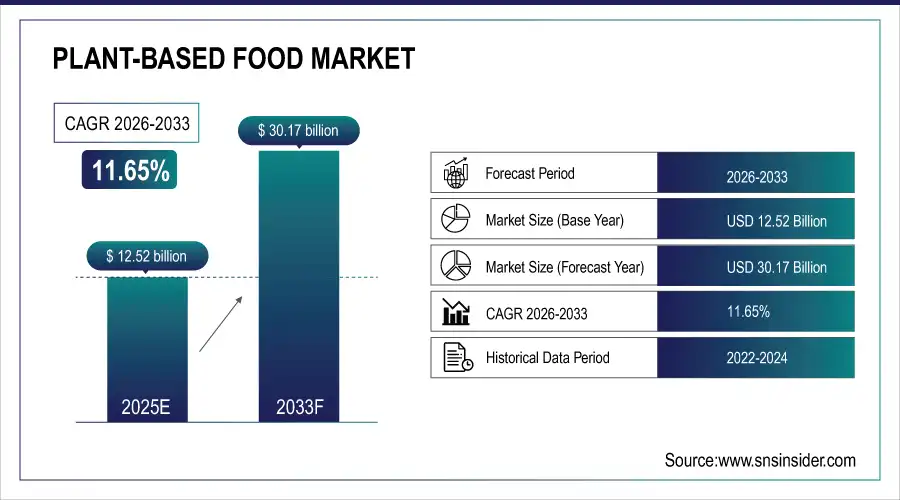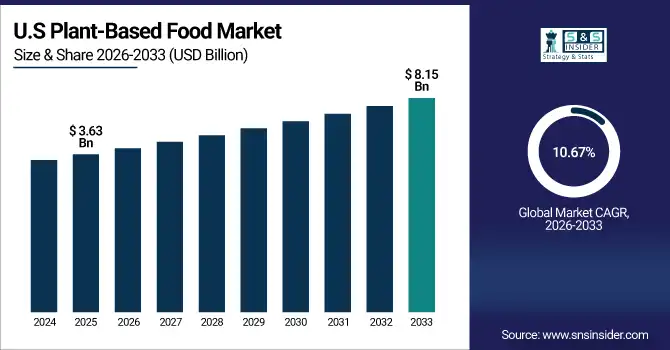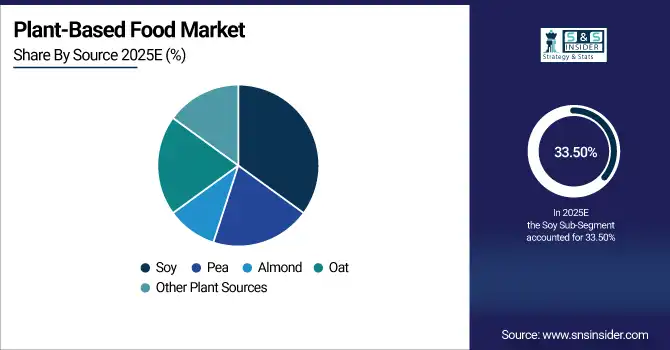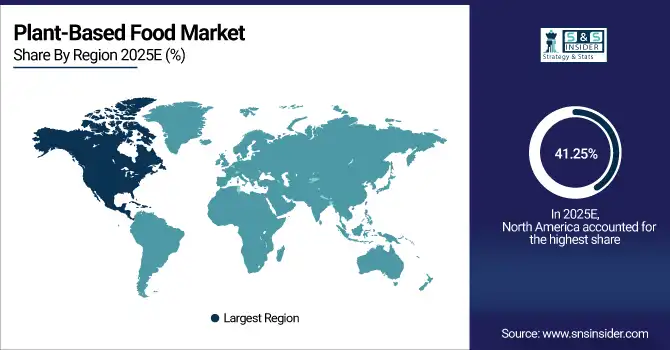Plant-Based Food Market Report Scope & Overview:
The Plant-Based Food Market size was valued at USD 12.52 Billion in 2025E and is projected to reach USD 30.17 Billion by 2033, growing at a CAGR of 11.65% during the forecast period 2026–2033.
The Plant-Based Food Market analysis focuses on the changing consumer preferences for sustainable food options and healthy diets. Increased consumption of meat and dairy alternatives, increasing scrutiny on environmental impact, and wider broadening distribution across retail and foodservice are spurring the market expansion powered by innovation.
Plant-Based Food consumption reached 8.3 million tons in 2025, driven by rising demand for meat and dairy alternatives and expanding retail and foodservice availability.
Market Size and Forecast:
-
Market Size in 2025: USD 12.52 Billion
-
Market Size by 2033: USD 30.17 Billion
-
CAGR: 11.65% from 2026 to 2033
-
Base Year: 2025
-
Forecast Period: 2026–2033
-
Historical Data: 2022–2024

To Get more information On Plant-Based Food Market - Request Free Sample Report
Plant-Based Food Market Trends:
-
Increasing demand for healthier and more sustainable diets is facilitating gaining traction around the world adopting plant-based food products.
-
Improvements in the sources of protein, flavor and texture are contributing to product appeal and widening the market.
-
Food-away-from home use of plant-based alternatives is growing but beyond home use of plant-based foods food service outlets are incorporating them.
-
Heightening consciousnesses of environmental and ethical issues is driving a consumer move from animal-based to plant-based alternatives.
-
Driving market competitiveness are manufacturers concentrating on fortified, clean-label and premium plant-based products to cater to changing consumer preferences.
U.S. Plant-Based Food Market Insights:
The U.S. Plant-Based Food Market is projected to grow from USD 3.63 Billion in 2025E to USD 8.15 Billion by 2033, at a CAGR of 10.67%. Growth is fueled by increasing consumer appetite for meat and dairy alternatives, healthful eating habits, sustainable goods, and robust retail and foodservice adoption.

Plant-Based Food Market Growth Drivers:
-
Rising consumer shift toward sustainable, protein-rich diets is accelerating growth in the Plant-Based Food market.
Rising consumer shift toward sustainable and protein-rich diets is the primary driver of the Plant-Based Food market growth. Growth of health consciousness, environmental conservation and ethical concerns are driving more people to follow a meat and dairy free diet. Increased accessibility at retail and foodservice, is also underpinning demand. Secondly, advances in taste, texture and fortification options and the availability of clean-label high-quality products are driving further market penetration and market growth.
Plant-Based Food consumption reached 7.4 million tons in 2025, driven by rising demand for meat and dairy alternatives and expanding foodservice and retail adoption.
Plant-Based Food Market Restraints:
-
High costs and limited consumer awareness are restricting large-scale adoption and supply expansion of plant-based food products.
High costs of raw materials and limited consumer awareness are significant factors restraining the growth of the Plant-Based Food market. Reliance on specialty plant proteins and substitute ingredients may be subject to the risk of price fluctuations and supply difficulties. Furthermore, limited dissemination of information about a plant-based diet and perceived taste or texture restrictions block acceptance. Smaller firms are often limited by production and distribution capacities, hindering the market expansion despite increasing consumer preference for sustainable diets.
Plant-Based Food Market Opportunities:
-
Growing interest in functional and fortified plant-based foods presents opportunities for innovative, health-focused product development globally.
Growing demand for functional and fortified plant-based foods presents a significant opportunity for the Plant-Based Food market. Protein-fortified and vitamin-infused or probiotic-added products can be developed to suit health-oriented consumers. Moving into ready meals, drinks and snacks is easily achievable. Sustainable and ethical consumption is also growing in popularity which fosters uptake, allows companies to distinguish their wares and attract new target groups and accelerating long-term market expansion.
Functional and fortified plant-based products accounted for 22% of new product launches in 2025, driven by rising health-conscious consumer demand.
Plant-Based Food Market Segmentation Analysis:
-
By Product Type, Meat Alternatives held the largest market share of 38.75% in 2025, while Dairy Alternatives are expected to grow at the fastest CAGR of 13.20%.
-
By Source, Soy dominated with a 33.50% share in 2025, while Pea is projected to expand at the fastest CAGR of 14.15%.
-
By Application, Home Consumption accounted for the highest market share of 41.25% in 2025, and Foodservice is projected to record the fastest CAGR of 14.05%.
-
By Distribution Channel, Supermarkets & Hypermarkets held the largest share of 47.30% in 2025, while Online Retail is expected to grow at the fastest CAGR of 15.30%.
By Product Type, Meat Alternatives Dominate While Dairy Alternatives Expand Rapidly:
The Meat Alternatives segment dominated the market due to extensive consumer convenience, high protein content and strong product offering in both retail and foodservice. The learning curve and quality gains have flattened adoption around the world. Dairy Alternatives is the fastest growing segment with plant-based milk, cheese and yogurt innovations driving momentum. Fortified products, exciting flavours and increasing awareness of lactose intolerance and sustainability are driving the move for these expanding beverages.
By Source, Soy Dominates While Pea Expands Rapidly:
Soy segment dominated the market owing to it being one of the most preferred, protein rich source across several applications for a long time. It’s common in meat and dairy substitutes, so manufacturers simply default to it. Pea is the fastest growing segment, owing to its allergen-free nature, neutral taste, and application in fortified & textured foods. Its rapid growth is fueled by increased research, new processing technologies and consumer demand for alternative protein sources.

By Application, Home Consumption Dominates While Foodservice Expands Rapidly:
Home Consumption segment dominated the market aided by rising consumer preference toward adding plant-based based meals in everyday diet Adoption is given a boost by convenience, health-consciousness and dietary fashions. The foodservice segment is the fastest growing segment as restaurants, cafés and caterers are embracing plant-based items to respond to ethical, environmental and dietary requirements. Menu proliferation, growing vegetarian and flexitarian diners, and exciting concepts are driving growth in this channel on all continents.
By Distribution Channel, Supermarkets & Hypermarkets Dominate While Online Retail Expands Rapidly:
Supermarkets & Hypermarkets segment dominated the market on account of easy availability and range of products offered with well-known brands which is a major purchasing channel for plant-based foods. Online Retail is the fastest growing segment, powered by e-commerce growth and convenience, subscription services and retargeting offers. Direct-to-consumer services, heightened awareness and tech-savvy younger consumers embracing online shopping is driving growth, with digital retail being a significant growth engine in the plant-based food universe.
Plant-Based Food Market Regional Analysis:
North America Plant-Based Food Market Insights:
North America dominated the Plant-Based Food market with a 41.25% share, driven by high consumer awareness of health, sustainability, and ethical eating. Growth is driven by broad retail availability, product innovation for meat and dairy alternatives’ formulations and greater penetration in the home and foodservice channels. Strong distribution networks and increasing popularity for fortified, clean-label, quality products strongly maintain the leading stance of the region in the market.

Get Customized Report as per Your Business Requirement - Enquiry Now
U.S. Plant-Based Food Market Insights:
The U.S. Plant-Based Food market is primarily driven by rising consumer preference for healthy and sustainable diet that includes meat and dairy alternatives, coupled with established retail and foodservice networks. Supported by advances in fortification and clean label, growing awareness of environmental and ethical values, increasing product availability, the market is set to continue expanding.
Asia-Pacific Plant-Based Food Market Insights:
The Asia-Pacific Plant-Based Food market is the fastest-growing at a CAGR of 13.04% with continuous growth in health consciousness, increasing vegetarian and flexitarian populations and high urbanization. Increasing trend of consumers switching to meat and dairy alternatives along with new product launches and risen retail sales & foodservice are some of the factors supporting market expansion in countries such as India, China, Japan, and Australia. Growing concerns for sustainability and ethical consumption are also driving the market’s high growth rates throughout the region.
China Plant-Based Food Market Insights:
China represents one of the largest Plant-Based Food markets, supported by increasing health consciousness among consumers, a rising vegetarian population and expanding urbanization. Rising popularity of meat and dairy alternatives, new product launches, expanding retail and foodservice distribution along with sustainable and fortified vegan offerings are further advancing new market opportunities.
Europe Plant-Based Food Market Insights:
Europe Plant-Based Food market is flourishing due to the rising consumer preference toward sustainable and healthy diet and growing demand for meat & dairy alternatives. Key markets for us: Germany, France and the UK. Expansion is driven by established retail and foodservice networks, innovation in fortified and clean-label products, increasing demand for environmental and ethical consuming awareness, rising government support for sustainably healthier food across the region.
Germany Plant-Based Food Market Insights:
Germany is a strategic market for Plant-Based Food, with strong consumption of meat and dairy substitutes. There’re strong retail and foodservice distribution, while health and sustainability are receiving more attention from consumers and fortified and clean label varieties are growing in popularity. Market growth is also driven by urbanization and ethical consumption trends.
Latin America Plant-Based Food Market Insights:
The Latin America Plant-Based Food market is steadily growing as consumers increasingly adopt meat and dairy alternatives. Growth is supported by increasing health consciousness, urban development, growth of retail and foodservice chains and sustainable consumption patterns. Volume and value growth for fortified, clean-label and ethically produced plant-based products are opening consumer segments throughout the region.
Middle East and Africa Plant-Based Food Market Insights:
The Middle East & Africa Plant-Based Food Market will also have the demand-led growth throughout the forecast period due to growing health and sustainability awareness among consumers, expanding urban populations, and rising use of meat & dairy substitutes. Increase in retail availability, government assistance and changing consumer tastes toward ethical and sustainable diets are driving the growth at regional level.
Plant-Based Food Market Competitive Landscape:
Beyond Meat, headquartered in the U.S., dominates the Plant-Based Food market through its innovation in meat alternatives and strong brand presence. The company’s products mimic the taste and texture of actual meat with pea and rice proteins and are appealing to both flexitarians and vegans. Beyond Meat is leading the pack through its commitment to sustainability, innovation in food and availability in leading retail and commercial channels setting itself apart as a leader of the plant-based protein sector.
-
In March 2025, Beyond Meat launched Beyond Ground, a simplified four-ingredient plant protein formula designed to replicate meat’s taste and texture, enhancing sustainability and consumer appeal. The launch expands its plant-based portfolio across retail and foodservice channels.
Impossible Foods has established itself as the leader in the Plant-Based Food market; a company people know due to their scientific approach they apply to making meat alternatives that taste real. Its so-called signature “heme” ingredient mimics the taste and smell of meat, differentiating it from rivals. Unceasing R&D, strategic restaurant alliances and an unwavering dedication to lowering environmental impact have bolstered Impossible Foods’ leadership position with explosive growth in commercial distribution and foodservice.
-
In June 2025, Impossible Foods introduced Impossible Steak Bites, its first pre-cooked plant-based steak alternative. Engineered for flavor, protein content, and convenience, this product targets both home and foodservice consumption, supporting Impossible Foods’ growth strategy in the plant-based meat sector.
Nestlé S.A., a food and beverage giant, dominated the Plant-Based Food industry on account of its broad range of product offerings and a robust distribution network. The company’s plant-based brands, which include Garden Gourmet and Sweet Earth, promote health, taste and sustainability. With advanced food technology, ongoing innovation and consumer trust, Nestlé leads the sector in response to this demand for plant-based options that are good for you and good for the planet.
-
In April 2025, Nestlé S.A. unveiled the Incredible Burger under its Garden Gourmet brand, made from soy and wheat proteins. Focused on health, taste, and sustainability, the product enhances the plant-based offerings, promoting innovation and reinforcing its leadership in the plant-based food market.
Plant-Based Food Market Key Players:
Some of the Plant-Based Food Market Companies are:
-
Beyond Meat
-
Impossible Foods
-
Nestlé S.A.
-
Danone S.A.
-
Unilever PLC
-
Oatly Group AB
-
Conagra Brands, Inc.
-
Tyson Foods, Inc.
-
The Hain Celestial Group, Inc.
-
Amy’s Kitchen, Inc.
-
Quorn Foods
-
VBites Foods Ltd
-
Garden Protein International, Inc.
-
Tofurky
-
Sunfed
-
Maple Leaf Foods Inc.
-
Blue Diamond Growers
-
Califia Farms LLC
-
Eden Foods Inc.
-
SunOpta, Inc.
| Report Attributes | Details |
|---|---|
| Market Size in 2025E | USD 12.52 Billion |
| Market Size by 2033 | USD 30.17 Billion |
| CAGR | CAGR of 11.65% From 2026 to 2033 |
| Base Year | 2025E |
| Forecast Period | 2026-2033 |
| Historical Data | 2022-2024 |
| Report Scope & Coverage | Market Size, Segments Analysis, Competitive Landscape, Regional Analysis, DROC & SWOT Analysis, Forecast Outlook |
| Key Segments | • By Product Type (Meat Alternatives, Dairy Alternatives, Snacks & Ready-to-Eat, Beverages, Others) • By Source (Soy, Pea, Almond, Oat, Other Plant Sources) • By Application (Home Consumption, Foodservice, Bakery & Confectionery, Restaurants & Cafes, Others) • By Distribution Channel (Supermarkets & Hypermarkets, Online Retail, Specialty Stores, Convenience Stores, Others) |
| Regional Analysis/Coverage | North America (US, Canada), Europe (Germany, UK, France, Italy, Spain, Russia, Poland, Rest of Europe), Asia Pacific (China, India, Japan, South Korea, Australia, ASEAN Countries, Rest of Asia Pacific), Middle East & Africa (UAE, Saudi Arabia, Qatar, South Africa, Rest of Middle East & Africa), Latin America (Brazil, Argentina, Mexico, Colombia, Rest of Latin America). |
| Company Profiles | Beyond Meat, Impossible Foods, Nestlé S.A., Danone S.A., Unilever PLC, Oatly Group AB, Conagra Brands, Inc., Tyson Foods, Inc., The Hain Celestial Group, Inc., Amy’s Kitchen, Inc., Quorn Foods, VBites Foods Ltd, Garden Protein International, Inc., Tofurky, Sunfed, Maple Leaf Foods Inc., Blue Diamond Growers, Califia Farms LLC, Eden Foods Inc., SunOpta, Inc. |

